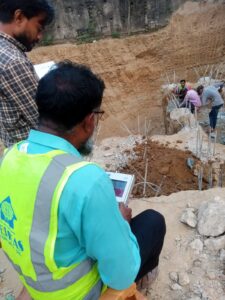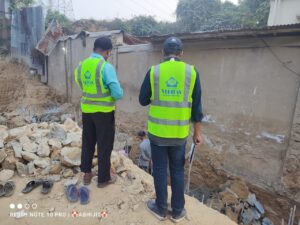




Pile Integrity Test OBJECTIVES OF THE WORK
The main objectives of the work are-
- Pile Integrity Test To estimate the length of the pile shaft.
- To estimate the quality of the pile shaft.
Pile Integrity Test SCOPE OF THE WORK
The scope of the work consists of the following:
- To conduct pile integrity tests on the piles at the site
- To know the quality of pile shaft and their approximate length.
- To find any irregularity in the pile shaft.
TEST DEVICES
The name of the Pile Integrity Test device used in this case is “Sonic Integrity Testing System” (SIT-System).The SIT-system is a dedicated instrument for carrying out sonic integrity testing on piles and is specially designed to resist rough handling and adverse site conditions. With the SIT-system, the integrity of foundation piles after installation can be accurately and efficiently verified. The SIT-system enables to check the pile length and to detect irregularities and/or cracks in the pile shaft.
The test is carried out by attaching a transducer onto a pile top while striking the pile head with a hand held a hammer. The SIT-system registers the impact of the hammer followed by the response of the pile and shows on the NoteBook Computer display. The signal can be stored in the memory of the SIT-system together with other information, such as pile number, date, time, site, amplification factor, filter length, etc.
The reflectograms are horizontally scaled and vertically amplified to compensate external soil friction, which facilitate the interpretation. Consequently, the reflection of the pile toe matches the length of the pile, which will be confirmed by the SIT-system. In case of any defects, the exact location can be determined from the graph on the display.
The pile length is used to determine the signal length. If the pile length is too short the measured signal will be too short to determine the pile toe. The pile Length should be estimated between 80 to 110 percent of the real pile length.
TEST METHODOLOGY
Pile Integrity Test
Low strain integrity testing of piles is a tool for quality control of long structural elements that function in a manner similar to foundation piles, regardless of their method of installation, provided that they are receptive to low strain impact testing.
The test provides velocity (and optionally force) data which assists evaluation of pile integrity and pile physical dimensions (i.e. cross-sectional area, length), continuity and consistency of pile material. The test does not give any information regarding the pile bearing capacity or about pile reinforcement.
Integrity test principles have been well documented in the literature (ASTM D5882-00; Klingmuller, O., 1993). A brief outline on the integrity test is presented here.
There exist two methods of integrity testing
- Pulse-Echo Method (PEM), and
- Transient Response Method (TRM)
In PEM, the pile head motion is measured as a function of time. The time domain record is then evaluated for pile integrity. In TRM, the pile head motion and force (measured with an instrumented hammer) are measured as a function of time. The data are evaluated usually in the frequency domain.
For testing the piles in the present case, the Pulse Echo Method was followed and a Sonic Integrity Tester (SIT) made by Profound B. V., the Netherlands was used. In this method, a small accelerometer is placed on the pile top and the pile head is struck with a small hammer. The stress wave thus generated travels down the pile shaft, reflects at the toe of the pile and is registered by the accelerometer.
The accelerations are then integrated to obtain the pile head velocity. Apparent reflections occurring prior to the toe response that are of the same sign as the input are due to a relative decrease of impedance. Reflections of the opposite sign are due to a relative increase of impedance.
The pile impedance z is defined by the following equation:
z = EA/c (1)
where, E = Young’s modulus of pile material
A = cross-sectional area, and
c = stress-wave velocity.
According to one-dimensional stress-wave theory, the stress-wave velocity (c) is given by the following equation:
![]() (2)
(2)
where, r is the mass density of pile material.
Combining the above equations (1) and (2), the following expression for pile impedance
(z) is obtained:
![]() (3)
(3)
Thus an impedance reduction can be caused by a decrease in area A, modulus E or density r. Since both E and r are related to concrete strength, it can be concluded that a change in impedance is related to a change in cross-sectional area or concrete quality.
The pile length is calculated from the time of toe reflection (T), and the velocity of wave propagation through concrete
(c) using the following equation:
![]() (4)
(4)
The magnitude of stress-wave velocity usually ranges from 9840 ft/sec to 13120 ft/sec. Integrity evaluation from low strain tests is to be made with due consideration to other information such as construction details (length of temporary casing, concreting methods, concrete consumption, etc.),
Soil profile, unusual occurrences during construction (e.g. delays during concreting, premature withdrawal of tremie tubes, water conditions, etc.).
The shaft friction between the pile and soil plays an important role in pile integrity test, as shaft friction dampens the magnitude of the signal.
The reduction in the magnitude of the signal is a function of pile length, pile type, soil type and consistency and the length to diameter ratio of the pile. If reflectograms are obtained from a reference pile of known length and good quality (such as a driven pile) at the same site then the effect of soil resistance can be judged and an improved interpretation can be made.
Certain limitations are inherent in low-strain integrity testing. Integrity evaluation of a pile section below a crack that crosses the entire pile cross-sectional area or below a section filled with soil is not normally possible since the impact wave is likely to reflect completely at the discontinuity. Piles with highly variable cross-sections or multiple discontinuities are difficult to evaluate.
Integrity testing may not identify all imperfections, but it can be used in identifying major defects within the effective length. In literature, there are many examples that highlight the success of low strain integrity testing (Klingmuller. O, 1992).
Releted Test:
